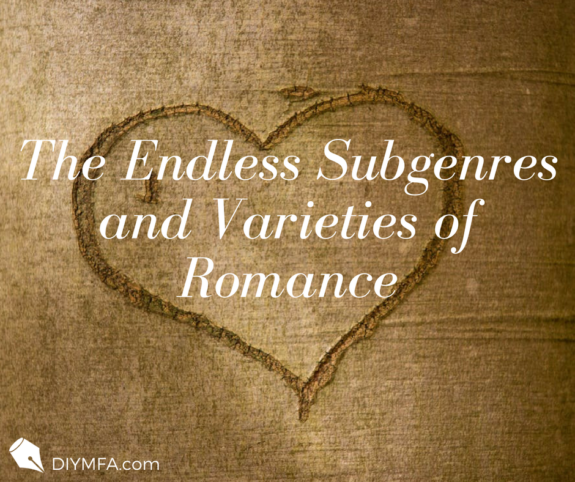Saying, “I write romance” to a romance connoisseur isn’t enough. The next questions is: what kind?
There are different age categories, subgenres, heat levels, and tropes. Before you can write romance you have to know the ins and outs of the genre to learn where your book will fit in the market. Knowing how to direct it to the right audience is the key to selling it.
Romance readers are very specific in what types of romance they like to read. Many will hop back and forth between different kinds, but when they want to read a certain type of book, they’re looking for a clear cut message that they’ll get it. They all want HEA (Happily-Ever-After), but there are too many ways to count to get there.
Age Categories
To start broadly, romance comes in three age categories: young adult (teen), new adult (“college age” or 18-23 approx.), and adult. Generally, writers don’t hop between categories. If they do, they’ll usually use a separate pen name so as not to confuse readers. Sometimes writers who cross subgenres will also have multiple pen names.
Romance Subgenres:
Historical Romance
This is the one that most people who know nothing about romance think they know. The “bodice rippers” they call them, but really it divides itself into its own categories. There are as many different kinds of historicals, corset wearing and not. RWA (Romance Writers of America) classifies it as any novel taking place before 1950. If you know anything about history, that’s a lot of years. Lots of them do take place in regency England, but there are others in a variety of other countries, centuries, cultures, from Medieval to World War II, from India to the U.S., with everything in between. And more. There’s so many I’ve never read. Imagine it and it’s likely been written.
Contemporary
A novel set from 1950 to the present, according to RWA (Romance Writers of America). This one divides itself up in massive variety as well. There’s sweet and dark and comedic and tragic. There’s urban and travel and small town, an endless different settings and cultures. It contains a large variation in heat level or sensuality, and an even larger variety of tropes (recurring themes or devices, example: friends / enemies to lovers).
Erotic Romance
Not to be confused with erotica, with the “A” on the end. They are two different things. RWA defines erotic romance as, “Novels in which strong, often explicit, sexual interaction is an inherent part of the love story, character growth and relationships and could not be removed without damaging the storyline.” Quite simply, the novel’s plot turns around the physical relationship of the characters. I’ve written a lot in this subgenre, so I know more about it. For the curious, I wrote on some writing techniques for writing plot driving and character developing loves scenes. Erotic romances can take place in a variety of settings. They can be contemporary, historical, or paranormal.
(Note: Yes, this is the subgenre of the infamous Fifty Shades of Grey, but be careful not to assume that all erotic romance involves BDSM. There are plenty of ways to write character growth and plot through a sexual relationship without it. This subgenre is different from erotica because it still has an HEA (Happily-Ever-After) and centers around a core romance relationship. Erotica does not require a happily-ever-after or a love story and so is a separate genre from romance all on its own.
Romance with Religious or Spiritual Elements
Previously known as the “Inspirational” subgenre, it’s grown into a much broader definition of a novel where the spiritual journey of the characters is an inherent part of the romance. I confess this is the one subgenre I’ve not read any books in so I can’t make much comment, but I’m happy to quote RWA that, “These novels may be set in the context of any religious or spiritual belief system of any culture.” And so the possibility of variety is as great as any romance subgenre.
Suspense
The suspense category is romance dressed up in mystery, thriller or suspense format. The suspense elements are integral to the plot. They have qualities of those other genres of fiction but with a central romance plot. My new book is a thriller about a stalker and so falls into this category. Often it involves, a crime, detectives or police work, but not always. A mystery or bad guy of some sort is frequently included.
Paranormal
You’d think this one would be straight forward. They’re all vampires and werewolves, right? Nope. Think settings of science fiction or fantasy, any world with extraordinary elements, magical or technological. Again, it’s a central romance that turns the plot, but the paranormal elements are inherent and the story would not work without them.
All of these subgenres contain a variety of “heat levels,” the industry term for degrees of sensuality. They can be sweet or closed door, they can be high heat and ultra-sexy. Though if they get super explicit, they fall into the erotic romance subgenre. They come in a variety of lengths, frequently in long novel format, but novellas are also popular and many write shorter stories or anthologies.
One last note I’d like to emphasize, the romance genre represents a broad diversity of cultures, and not every romance is written for a heterosexual couple. There are LGBTQIA, polyamorous, and more.
I’ve left a lot out, and I’ve given none of them their due justice. The hard part as a writer is knowing where your book fits amidst the options and how to market it toward the audience it needs to find.
Who knew there were so many different ways to write Happily-Ever-After?
Romance readers do.

Robin Lovett writes contemporary romance, and her next series of dark romances will release through SMP Swerve summer 2017, beginning with STRANGER. She loves to chat on Twitter @LovettRomance and every Sunday evening you can find her with other romance writers at #RWChat. She is represented by Rachel Brooks of the L. Perkins Agency.







